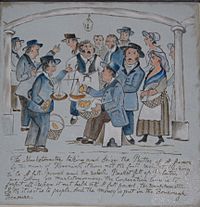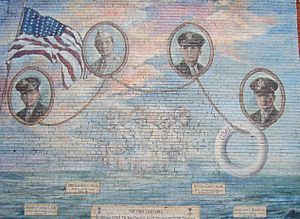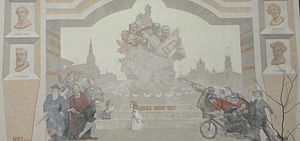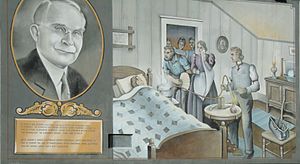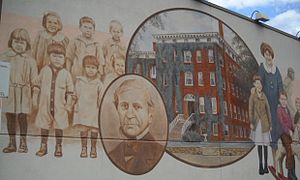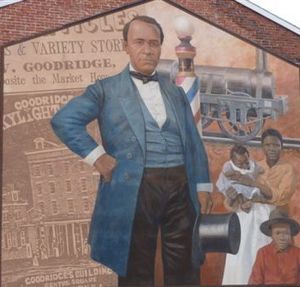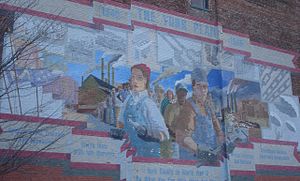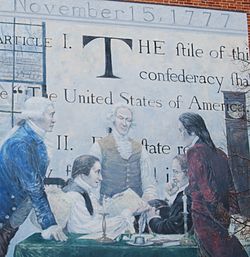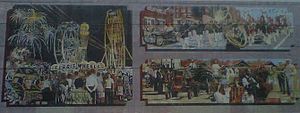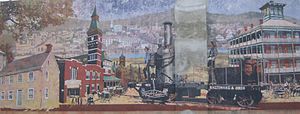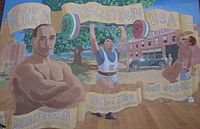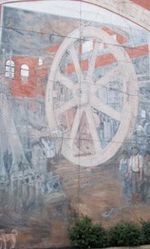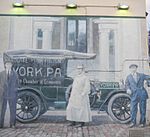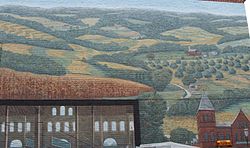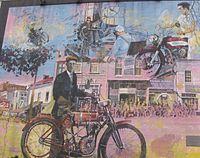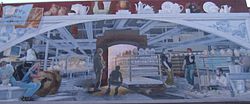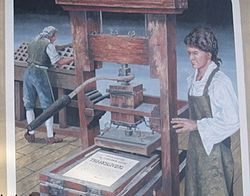- Murals of York, PA
-
The Murals of York, PA are a series of murals painted on the sides of buildings in York, Pennsylvania between 1996 and 2002. Paid for with local donations, the murals provide the community with details about some lesser-known people, businesses, and customs of the city while adding artistic beauty. The York County Heritage Trust owns and shares rights to the use of the mural images.
History
In the 1990s a group of individuals from York traveled to Chemainus, Vancouver Island, British Columbia. David Carver, the president of the York Redevelopment Committee at that time, was among the group. Chemainus had a series of murals depicting the town's history that had been successful in drawing tourism to the area. The York group was interested in viewing these murals and deciding whether a project like this would work in York. A committee was later formed and the York Mural Project was begun. There are a total of 18 large murals and a series of mini-murals. Each mural depicts the history or York and is painted on the side of a building. The first mural was painted in 1996. It depicted the Harley Davidson plant. The first mini-mural was painted in 1998. The last mural was completed in 2002.[1] The murals are unique because they depict some little known people and events in York's history. Each mural tells a little story.[2] The money to pay for the mural project came from donations from businesses and townspeople who were interested in the project.[1]
The murals were painted during the day by artists who used scaffolding. The mini-murals were copies from a book by Lewis Miller; these mural images were projected on the wall via an overhead projector at night and sketched, for painting during the day.
A coat of Dryvit was applied as a base for each mural. Outdoor house paint was used and then covered with a clear coat. The clear coat protects the mural from weather and graffiti. The life of each mural is about twenty years. Some of them are already disintegrating.[1]
Lewis Miller Mini Murals
Without Lewis Miller's drawings, there would be far fewer visual clues about what life was like in the 19th century in York. Lewis Miller did some funny drawing such as his portrayal of Mrs. Schreck. She had yellow toenails that were so long that Mr. Schreck had to cut them off with a saw, and she could not wear shoes.[1] Artist Justine Landis and her daughter, Lori Straup turned Lewis Miller's drawings into mini murals.[1] The mini murals are funny but also show serious scenes about the life back in the 19th century. Some mini murals bear Miller's writing in both German and English underneath the pictures. Most Yorkers spoke at least some German in the 18th and early 19th centuries.[1] One mural shows him at work in his carpentry shop. He had hundreds of drawings in his journal and there were so many that a committee selected which murals to feature.[1] Even though the mini murals are larger than life-sized drawings, they are still smaller than the other Murals of York. Some of them are featured in Cherry Lane park, and on the side of the town's Central Market house. There are 16 mini murals in all.[3]
Four Chaplains Mural
You probably never met somebody as brave as the Four Chaplains who gave their lives up for other strangers. The Four Chaplains were placed on a mural in York, PA. Connie Burns Watkins painted this mural to show how the 4 Chaplains risked their lives to save their fellow men in uniform. The Four Chaplains mural is 23 feet wide and 24 feet high.[3] The top of the mural shows the Four Chaplains that sacrificed their lives. The four people that are at the top of the mural are George L. Fox,(Methodist); Clark V. Poling,(Dutch Reformed); Alexander D. Goode (Jewish); and John P. Washington, (Roman Catholic). Alexander D. Goode lived in York.[3] Among the Four Chaplains there is a rope connecting each portrait representing their love and peace together. There is also a life raft hanging from the long rope that represents the life rafts that the Four Chaplains gave up for other people. The middle shows the Chaplains linking arms. They are very faint in the mural because they are rising up to heaven together. The bottom of the mural shows the very icy waters that represent the Four Chaplains' graves.[4] One will always remember the history of the Four Chaplains because they sacrificed their lives to save other people when a torpedo hit their ship during World War II. The mural reminds people of this act of bravery.
Community Contributors Mural
The Community Contributors mural is layered like a cake. This mural, The Community Contributors mural has a first layer, a second layer, and even a third layer.[4] The first layer is about the people that help our community such as Samuel Small, John C. Schmidt , Josephine N. McClelland, and A.B. Faquhar. Each one did something really good. For example, Samuel Small helped found the York Collegiate Institute that is now the York College of Pennsylvania. A.B. Farquhar is known as one of York's leading businessmen in the Industrial Revolution and philanthropist. He also made contact with the Confederates early in the Civil War and learned information that would help the Union. Josephine N. McClelland was known for being a local teacher that helped found the YWCA and was a prominent suffragette. John C. Schmidt was a prominent businessman and helped form the first York Bank and was one of the founders of York Manufacturing Association as well as starting a chain company and Schmidt and Ault Paper Company. He also started the York chapter of the American Red Cross during World War I.[3] The second layer is about the community's commitment to help one another. This commitment comes in various fields-arts and eduction, children and family's, health care, sports, and work. A monument brings together several deceased leaders whose legacy honors the community-George Bowles, Mahlon, Haines, Anna Huber, Ben Lavetan, Thomas Hartley and Charles S. Wolf.[3] The third layer is about various services. There are a lot of organizations helping our community. Some of these are fire stations, churches, and libraries.[4] They all helped in special way. The background is telling us that for over 250 years people have really been helping one another.
Dr. George Holtzapple Mural
Dr. George Holtzapple, a creative and intelligent physician is the focus of this York mural. The artist, Wayne Fettro, painted this mural to represent Dr. Holtzapple's achievements. On the right, the mural shows Holtzapple. He was smart enough to make a way to give air for a 16 year old boy who could not breathe. Also, on the right side of the mural is the invention that Dr. Holtzapple used to give the boy air.[4] This mural shows when Dr. Holtzapple got a call that a sixteen year old boy could not breathe. The boy really needed Dr. Holtzapple's help. Dr. Holtzapple has been a doctor for less than a year. It was 1885 when Dr. Holtzapple got call from the sixteen-year old boy's family. They said the boy could not breathe and had pneumonia. When Dr. Holtzapple arrived the boy told him "Give me air!" Dr. Holtzapple tried an experiment to produce oxygen. His experiment worked and Dr. Holtzapple gained credit for this treatment of pneumonia! On the left side of the mural shows a picture of the doctor and some information about him.[3] The mural was finished in October 2000. The size of the mural was 25 feet and 6 inches wide and 16 feet high.[3] Dr. Holtzapple's invention was later used to treat pneumonia and widely used in World War I for victims of gas attacks.[4]
The Children's Home Mural
The Children's Home Mural is historical and magnificent. It represents more than 100 years of caring for children all over central Pennsylvania. At first it was an orphanage founded by Samuel Small to aid white children in the aftermath of the Civil War. The reason they took the children in is because the Civil War took the lives of many fathers and disrupted the family structure. Mary Sitler Cooper was the person who looked after the children. As the decades passed the Children's Home became more than an orphanage for white children. Eventually the home opened its doors to all types of children who were in need.[4] Counselors, volunteer mentors and foster parents cared for children of all ages and races. The types of needs and services offered also have grown big time. They have increased because they started connecting kids to the community. They did this by letting the kids attend things like public schools, Boy Scouts, Girl Scouts, and the YMCA. In fact, the Children's Home services were used so much that its leaders constructed a new home in Springettsbury Township.
The original Children's Home, demolished in 1973, was on the southeast corner of Philadelphia and Pine streets.[4] The left part of the Children's Home mural shows Civil War orphans. Moving to the right the mural shows creator Samuel Small. Farther over is a teacher, a girl, a boy and one another boy on a rocking horse. Behind them are three children running to the right of the mural. On the far right is the current building, built in 1990. There is a man and a child, the man is pointing to the right like he is pointing to the future. The home is known as a place that truly cares for those who are in need and is working to making life better for these children.[3] Don and Jared Gray are the artists of the Children's Home of York mural. This wonderful mural is 80 feet wide and 18 feet high! [3] It was finished by the year 2000 in September and the Sponsor was the Children's Home of York, of course. Check out this beautiful portrayal of York's involvement with the community at 132 South George Street.
William Goodridge Mural
Very wonderful and determined are words that describe William Goodridge. He was wonderful because he helped slaves escape on the Underground Railroad and because even though he was born a slave he became a successful businessman. He moved from Maryland to York.[3] As shown in the right corner of the Goodridge mural, there is a baby with a mother. This baby is William Goodridge. Also, in the right corner, there is a young boy. This is William Goodridge as a child. William was born a slave. Later, in 1822, he was freed and then he opened a 5-story building, and a Barbershop on York Centre Square.[4] After he was freed he started helping other slaves through the Underground Railroad.[2][3] Don and Jared Gray painted this mural to honor him. The mural was finished in 2000, in the month of June. The mural is 24 feet wide and 23 feet high. The reason they created this mural was to show that if you are determined to do something you can do it, just like William Goodridge. He inspired us all. Even enough to make a mural about him!
York Goes to War: A Community Responds
This 28 feet high and 80 feet wide mural can be seen along South George Street on the north wall of Bell Socialization Service. Michael Webb was the talented artist who created and painted the mural in August 1999.[3] The York Goes to War mural is a reflection of how the community of York came together during World War II.[4] During this time York had factories that manufactured and supplied weaponry. Many men in the community went to war, so the women had to take over the factories. The role of women changed and they became a more important part of the community.[2] The people of York would often be heard saying, "Do what you can with what you have." They did what they could even though they were a small community. York received several flags from the government, which can be seen in the mural. The E flags represent excellence and pride in the work that the community of York contributed.[4]
The Articles of Confederation
The mural was finished in 1999 and you can go see it today at 166 West Market Street. The mural shows the members of the Second Continental Congress meeting to discuss the Articles of Confederation at the courthouse in York. The Articles of Confederation included rules that they wanted the 13 colonies to follow. Many men took a lot of time to discuss what should be in the Articles of Confederation, which were sent to the 13 colonies for approval in 1777. The Articles of Confederation were also adopted as the nation's first Constitution.[2] The mural shows the important role York played in the writing of the Articles of Confederation. The mural is 21 feet wide and 20 feet high. David Naydock from Pottsville brought this special moment to life.[3]
York Fair
Artist Alan Wylie completed the York Fair mural in 1999. It is 120 feet wide and 24 feet tall. The panels of the mural show how the York Fair has changed since it originally began in 1765. The fair continues to grow and includes a petting zoo where you can see cows, pigs, and bunnies, there are games, rides, concerts, fireworks, and other entertainment. The fair takes place during the month of September.[4] Now most people don't ride horses to the fair or march in a parade, but many people still find time to enjoy the special activities. One year over 700,000 people attended the fair. You can check out the colorful mural on East Market Street near Duke Street.[3]
York in the 1800s
The artist of the York in the 1800s century mural is C. Michael Svob. The mural is about life in York in the 19th century. The mural shows special landmarks and lets you catch a glimpse of what these landmarks looked like in York during the 19th century. It features landmarks in York such as the National House, the White Hall Hotel, the City Market House and Codorus Creek.[4] York's population increased during the 19th century and the creativity of York's people also developed during this time.[4] The York in the 1800s mural is 60 feet wide by 20 feet high. You can find this mural at 237 West Market Street along the East Wall.[3]
Muscletown USA
This mural was finished in August 2000. It was painted by Max Mason. It is 27 feet wide and 22 feet high.[3] It was painted because Bob Hoffman was called the "Father of Weightlifting" and the York Barbell company is very popular. Bob Hoffman also donated land to the YMCA to create the Dover Branch of the YMCA.[4] In the picture you can see Tommy Kono and John Grimek.[3] It is located at 37 West Philadelphia Street in York.
York Manufacturing Company
This mural was finished in 1995. It was painted by Dan Hendrix. It is 32 feel wide and 35 feet high.[3] It was painted because York Manufacturing was an important company in York. York manufacturing made ice-making machinery. The picture is of a huge wheel that was part of a machine that helped to keep things cold.[4] It is located at 150 Roosevelt Avenue in York.
Made In York
This mural was finished in 1998. It was painted by David Nadyock. It is 17 feet wide and 17 feet high, so it is a square.[3] The picture is of a Pullman car. They were made in York. The company started in 1903 and went out of business in 1917.[4] This picture shows one of their cars. They were known for making a six-wheeled car. You can find this mural at 243 West Market Street in York.
From Farm to Market
This mural was finished in 1997. It was painted by Marion Stephenson. It is 32 feet wide and 26 feet high.[3] This is a picture of the fields and the market where people took things that they grew to sell. The market in York started in 1755. There is still the Central Market in York that people still go to today.[2] You can find this mural at 36 North Beaver Street across from the York Central Market.
The Harley-Davidson Tradition
This mural was finished in 1996 and it was the first one painted in the Murals of York series. It was painted by Michael Svob. The mural is 34 feet wide and 26 feet tall.[3] The mural is about Harley-Davidson motorcycles. The company came to York in 1973 and used a plant that used to make bombs and bowling balls.[4] The picture shows motorcycles in downtown York, the Jefferson Hill Climb, and people working on motorcycles. You can find this mural at 258 West Market Street in York.
The History of Pottery
This mural was finished in 1998. It was painted by Michael Webb. It is 70 feet wide and 24 feet high.[3] The mural is about Pfaltzgraff because they were an important company in York. It was started in 1811 and is the oldest operating commercial pottery maker in the United States.[4] The picture has many things in it. There are Pfaltzgraff's most recognizable designs, a time line of the things they made, and pictures of how they make pottery.[2] There is also a real drainpipe that was painted around and then turned into a flagpole in the picture.[2] This mural is on 50 North George Street.
The Power of the Printing Press
This mural was finished in 1999. It was painted by Alan Wylie. It is 28 feet wide and 20 feet high. The mural is about things being printed in York.[3] The Continental Congress used the printing press a lot when they were in York. They needed things made to help raise support for their fight against the British. York's first newspaper was the Pennsylvania Gazette and it was made from December 20, 1777 to June 20, 1778.[4] You can find this mural at 223 North George Street in York.
Notes
- ^ a b c d e f g Landis, Justine. (Producer). (2010, December 8). Mrs. Landis visit [Audio Podcast]. Mrs. Landis Visit. Retrieved from http://www.livescribe.com/cgi-bin/WebObjects/LDApp.woa/wa/MLSOverviewPage?sid=sx2SKbDRnVhJ
- ^ a b c d e f g York mural project, Mr. McClure [Audio Podcast]. (2010, December 23). York Mural Project, Mr. McClure. Retrieved from http://www.livescribe.com/cgi-bin/WebObjects/LDApp.woa/wa/MLSOverviewPage?sid=TXHxvfj2j4pD
- ^ a b c d e f g h i j k l m n o p q r s t u v w McClure, James. (Ed.). (2002). Murals of York. York, PA: York Daily Record.("York mural project,," 2010)
- ^ a b c d e f g h i j k l m n o p q r s Bochy, Patrick. (Producer). (2010, December 16). York murals, York Heritage Trust [Audio Podcast]. York Murals, York Heritage Trust. Retrieved from http://www.livescribe.com/cgi-bin/WebObjects/LDApp.woa/wa/MLSOverviewPage?sid=wk7rnS6HXL2b
References
- McClure, James (1999). Never To Be Forgotten. York, PA: York Daily Record. pp. 10–14, 37–210. ISBN 1-929348-06-1.
- McClure, James. "The Murals Of York, A Walking Guide". York Daily Record. York Daily Record. http://www.ydr.com/murals. Retrieved 12 December 2010.
- York mural project, Mr. McClure [Audio Podcast]. (2010, December 23). York Mural Project, Mr. McClure. Retrieved from http://www.livescribe.com/cgi-bin/WebObjects/LDApp.woa/wa/MLSOverviewPage?sid=TXHxvfj2j4pD
- Landis, Justine. (Producer). (2010, December 8). Mrs. Landis visit [Audio Podcast]. Mrs. Landis Visit. Retrieved from http://www.livescribe.com/cgi-bin/WebObjects/LDApp.woa/wa/MLSOverviewPage?sid=sx2SKbDRnVhJ
- Bochy, Patrick. (Producer). (2010, December 16). York murals, York Heritage Trust [Audio Podcast]. York Murals, York Heritage Trust. Retrieved from http://www.livescribe.com/cgi-bin/WebObjects/LDApp.woa/wa/MLSOverviewPage?sid=wk7rnS6HXL2b
- McClure, James. (Ed.). (2002). Murals of York. York, PA: York Daily Record.("York mural project,," 2010)
External links
- The Murals of York – A Walking Guide, York Daily Record
Categories:- York, Pennsylvania
- Murals
- Art in Pennsylvania
- Histories of cities in Pennsylvania
Wikimedia Foundation. 2010.

